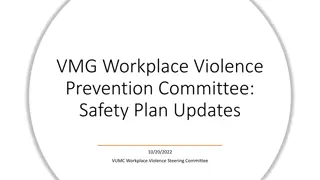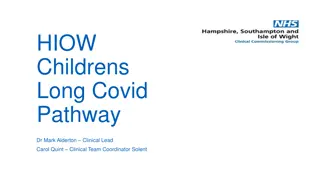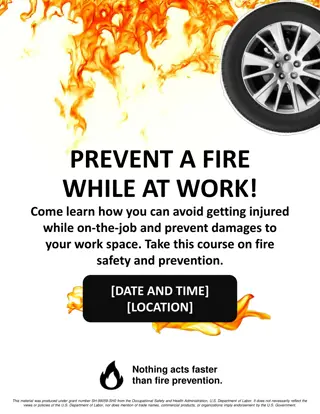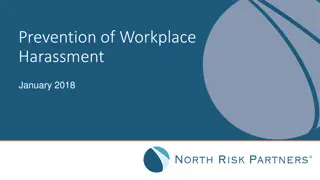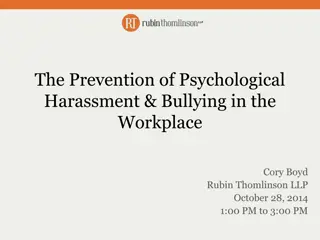Workplace COVID-19 Prevention Program Overview
Workplace COVID-19 Prevention Program (CPP) is essential to ensure employee health and safety by preventing COVID-19 exposure and spread. The program includes employee training, implementation of preventive measures, cleaning protocols, quarantine procedures, and return-to-work guidelines. Regular site evaluations, compliance checks, and detailed plans for handling COVID-19 incidents are crucial for maintaining a safe work environment. Awareness of COVID-19 facts, symptoms, prevention measures, and the importance of following safety protocols are emphasized in the program. Effective employee training and compliance with safety measures are vital in controlling the spread of COVID-19 in the workplace. Development of prevention programs is mandatory as per Cal/OSHA regulations. The program aims to create a healthful work environment and protect both employees and the public.
Download Presentation

Please find below an Image/Link to download the presentation.
The content on the website is provided AS IS for your information and personal use only. It may not be sold, licensed, or shared on other websites without obtaining consent from the author.If you encounter any issues during the download, it is possible that the publisher has removed the file from their server.
You are allowed to download the files provided on this website for personal or commercial use, subject to the condition that they are used lawfully. All files are the property of their respective owners.
The content on the website is provided AS IS for your information and personal use only. It may not be sold, licensed, or shared on other websites without obtaining consent from the author.
E N D
Presentation Transcript
COVID 19 Prevention COVID 19 Prevention Program Employee Program Employee Training Training January 9, 2021
Overview Overview COVID-19 Prevention Program (CPP) COVID-19 Facts COVID-19 Prevention Measures Cleaning and Disinfecting Quarantine & Return to Work COVID-Related Benefits
COVID COVID- -19 Prevention Program (CPP) 19 Prevention Program (CPP) The CCP s purpose is to ensure the health and safety of employees in the workplace by preventing The CCP s purpose is to ensure the health and safety of employees in the workplace by preventing COVID COVID- -19 exposure and infection spread. It sets forth policies and practices to support and maintain a 19 exposure and infection spread. It sets forth policies and practices to support and maintain a healthful work environment healthful work environment Why is this important? Employee training and compliance with safety measures is vital to controlling the spread of COVID-19 in the workplace. To ensure maintain safe environment for employees and the public. It is not intended to revoke employee rights Development of prevention program is required by Cal/OSHA COVID-19 prevention temporary emergency standards effective November 30, 2020
Agency Specific Plan Agency Specific Plan Regular evaluation of sites for plan compliance and correction of deficiencies to prevent exposure Investigation of COVID-19 illness incidents and determination if work-related factors could have contributed to increased risk of infection Identification and notification of close contacts (within six feet for cumulative 15 minutes or more in a 24 hour period) of an infected employee, with isolation of COVID-19 positive employee(s) and close contacts Employee Training
COVID COVID- -19 19 Facts Facts - - Symptoms Symptoms Cough Fever over 100.4 Difficulty breathing or short of breath Congestion or runny nose Headache Sore throat Chills New loss of taste or smell Fatigue Muscle or body aches Nausea or vomiting Diarrhea
COVID-19 Prevention Measures Don t come to work ill or after close contact with COVID-19 Social distancing of at least six-feet Avoid personal contact, i.e. virtual meetings Face coverings with cloth mask Wash your hands frequently Cough or sneeze into your elbow Clean and disinfect surfaces
Prevention Measures Prevention Measures Seek medical attention if your symptoms become severe, including persistent pain or pressure in the chest, confusion, or bluish lips or face Self-screen at home, including temperature and/or symptom checks Handwash frequently with soap and water, scrubbing with soap for 20 seconds Use hand sanitizer when handwashing is not possible
Wear Your Face Covering Wear Your Face Covering COVID-19 is spread through the air when an infectious person exhales, talks, coughs, or sneezes. Cloth face covering over nose and mouth without visible openings Required when inside except when alone in a room or seated in personal cubicle not facing adjacent occupants Face coverings protect the wearer and others close by Employees should wash or sanitize hands before and after using or adjusting face coverings. Avoid touching eyes, nose, and mouth Face coverings should be washed after each shift
Maintain physical distancing of at least six feet Management and all staff should assess personal and common work spaces to ensure safe distancing is maintained Limit the number of individuals riding in an elevator to maintain safe distancing Physical Distancing at Work Sites
Other Physical Distancing Other Physical Distancing Considerations Considerations Staggering employee breaks Limit nonessential travel and encourage virtual meetings Avoid handshakes and similar greetings that break physical distance Avoid congregating in lobbies, elevators, other common areas
Site cleaning staff will clean high traffic areas: break rooms and lunch areas entries and exits stairwells escalators handrails elevator controls doorknobs, toilets, and handwashing facilities Disinfecting Protocols Disinfecting Protocols Site Cleaning and Site Cleaning and
Workspace Cleaning and Disinfecting Protocols Employees should clean and disinfect personal work areas often You will be provided time to clean before and after shifts Avoid sharing phones, other work supplies, or office equipment wherever possible. Never share PPE
Cleaning and Disinfecting Shared Work Areas Cleaning and Disinfecting Shared Work Areas Designated Employees should clean the following: copiers fax machines printers telephones keyboards staplers surfaces in reception areas shared work stations
Quarantine and Quarantine and Return to Work Return to Work Temperature and/or symptom screenings to exclude ill workers Exclude workers who have had close contact to infected individuals at work Exclude workers who have had close contact with infected individuals at home Return to work criteria established by Public Health and Employee Health Services following CDC and Calif. Dept. of Public Health guidelines
Telecommute opportunities Potential options Potential options that may be that may be available when available when unable to go to unable to go to work due to illness work due to illness or close contact at or close contact at work or home work or home County Attestation Time Sick time Regular pay Workers compensation
What you can do
Questions? Contact your Safety Coordinator or Human Resources representative
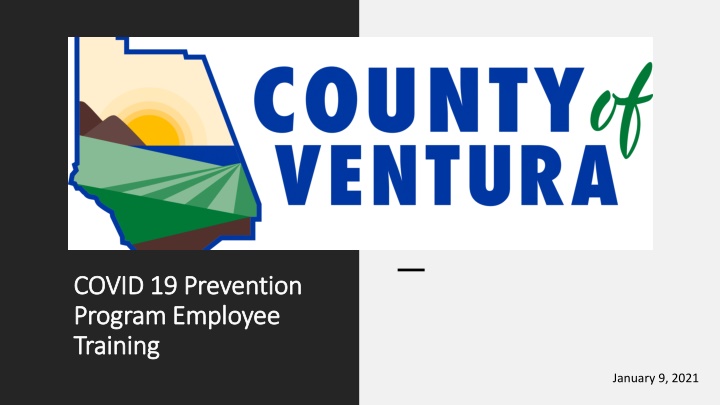



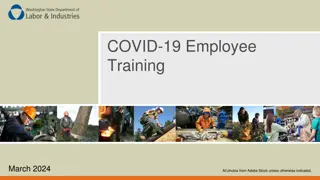

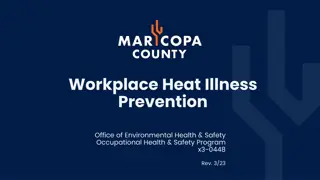

![Workplace Violence Prevention Plan in [District]: Definitions, Elements, and Implementation](/thumb/117038/workplace-violence-prevention-plan-in-district-definitions-elements-and-implementation.jpg)

